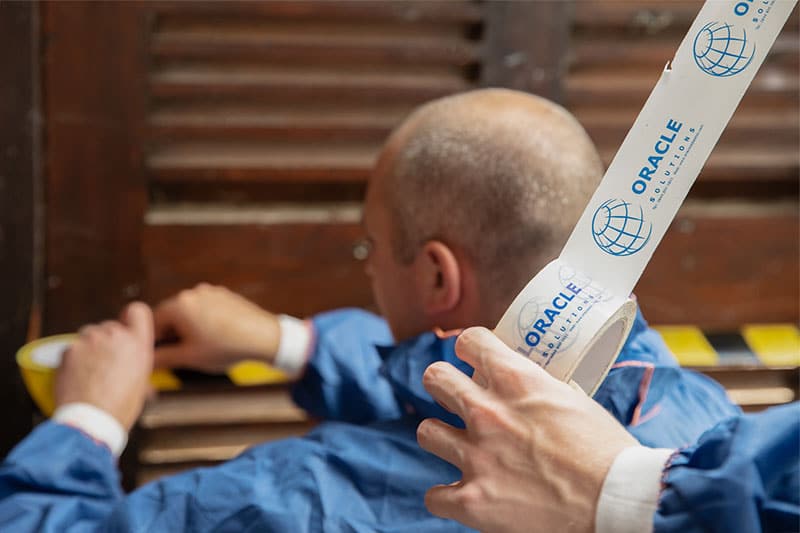What is an asbestos risk assessment? Regulations and guidelines
However, asbestos-containing materials (ACMs) can still be found in buildings that were built before that year. When ACMs are damaged, they release asbestos fibres into the air, which are then inhaled and become dangerous to one’s health.
Both workers and visitors in a building with damaged asbestos are at risk of developing mesothelioma and other cancers after exposure to airborne fibres.

What is an asbestos risk assessment?
If a workplace contains or may contain asbestos, an asbestos risk assessment must take place before work begins. It has to occur far enough in advance that safety measures can be implemented.
The risk assessment will cover (1) the asbestos risks that are present and (2) the precautions required to keep everyone safe from asbestos exposure.
Do I need an asbestos risk assessment?
According to the Health and Safety Executive (HSE), if work could damage or disturb ACMs, then an asbestos risk assessment is necessary before that work begins. This includes normal, everyday work as well as planned projects.
The HSE, along with local authorities and the Office of Rail and Road, enforces asbestos regulations. If you fail to carry out the asbestos risk assessment, legal action could be taken against you, especially if an asbestos exposure event follows.
According to the HSE, “For dutyholders, the failure to adequately manage asbestos in premises is dealt with in the same way as any other issue that the inspector believes to be ‘a matter of evident concern’.” Some of the UK cases that involved asbestos and resulted in legal action can be found here.
To avoid compliance issues, it’s best to have an asbestos risk assessment carried out if your property contains asbestos, even if you believe that work won’t disturb the ACMs. You’ll avoid legal trouble, and if the asbestos situation on the premises changes, you’ll only have to update the record instead of starting the assessment from scratch.
Who can complete an asbestos risk assessment?
Only a person with experience in asbestos management and knowledge of the Control of Asbestos Regulations 2012 should conduct the risk assessment. This may be the employer, an employee who has received asbestos training, or an outside third party that specialises in asbestos risk assessments.
They need to be aware of the risks of asbestos and understand what’s necessary to keep the environment safe. Most importantly, the assessor needs to be able to make informed decisions about managing asbestos.
The five steps of an asbestos risk assessment
The five basic steps of an asbestos risk assessment are as follows:
- Identify health risks
- Identify the people at risk
- Establish safety precautions
- Record the assessment and brief employees
- Regularly review the assessment
This systematic approach is necessary so that every detail is addressed. Also, it ensures that you only communicate your findings once there’s been a full analysis of the site to avoid any confusion.
Step 1: Identify the health risks
The first task of an asbestos risk assessment is to visually inspect the site to find the presence of asbestos. This includes locating ACMs and determining where an ACM might be even if it’s not visible.
The asbestos assessor will look for the following:
- Types of asbestos present
- Quantity of asbestos present
- Condition of the ACMs
- Friability of the ACMs
- Projected exposure level
During this step, the building’s documentation, particularly the asbestos survey, is reviewed. The survey should detail the type of ACMs present, their conditions, and the likelihood of disturbance.
Additionally, the assessor should speak with employees and property owners in case they have information that’s not reflected in the documentation.
Part of this step is also detailing the risks of working with the ACMs and the equipment required. Workplace hazards, such as accessing hard-to-reach places, need to be considered and recorded as well.
Step 2: Identify who may be at risk
Next, the assessor will evaluate who is at risk of asbestos exposure, the level of risk posed and how risk varies in different parts of the building.
Generally, people who don’t work directly with or close to ACMs are at a lower risk than those who are in the vicinity of the ACMs. However, since asbestos fibres become airborne, are invisible to the eye, and can be inhaled without realising it, everyone’s safety must be considered.
Any of the following people can be at risk of asbestos exposure:
- Customers on the premises
- Employees working with or near ACMs
- Members of the public
- Visitors to the site
Work activities can put the public at risk of exposure, especially if the ACMs are disposed of properly.
For example, when an unlicensed asbestos removal company incorrectly disposed of asbestos waste, it ended up on the road and pavement. Anyone in the vicinity could have been exposed to asbestos fibres in the air.
Step 3: Establish the required safety measures
The asbestos risk assessment will include a list of control measures so that the work can be planned and carried out safely. The goal is to either (1) remove the risk entirely or (2) reduce the risk to the lowest level possible.
Most of the time, you can’t eliminate 100% of asbestos exposure, but control measures limit the amount of asbestos exposure that will occur.
Asbestos control measures include the following:
- Installing ventilation to reduce the fibres in the air without impacting the rest of the building.
- Giving workers personal protective equipment (PPE), including respiratory protective equipment (RPE).
- Wetting certain types of ACMs and enclosing the asbestos to limit fibre spread.
- Confining the entire building or property to control where asbestos fibres travel.
- Properly disposing of asbestos waste.
- Decontaminating equipment, PPE, and tools.
- Creating emergency procedures.
Unsafely storing or disposing of ACMs could put people’s health at risk and also result in fines or other legal troubles for the duty holder. Plus, certain types of asbestos waste can only be handled by a licensed professional.
Step 4: Record the assessment and inform employees of its findings
Once the assessment is completed, the employer must record all of the findings.
The record can be kept either on paper or electronically on a device that’s accessible by employees. However, note that the record must be kept on-site and be made available to employees who want to view it.
The record should include all of the risk assessment steps, such as:
- Identified asbestos-related hazards
- The people who may be affected
- Control measures to reduce risk
- Work activities that could impact the ACMs
- The people who will be doing the work
- The duration of the work
Even though the asbestos risk assessment record will be available to employees, you must also communicate your findings with them. It’s important for them to understand the risks present even if they don’t opt to read the record.
Let employees know about the asbestos risk assessment findings, including the following information:
- The potential asbestos-related risks that the employees face.
- Precautions that employees must follow to stay safe.
- Plans for what to do in an asbestos-related emergency.
Emergency procedures should include details about how to evacuate the building, how asbestos waste is managed, decontamination procedures, and what to do if you’re been exposed to asbestos.
Step 5: Review and update the assessment regularly
Even though the asbestos risk assessment is completed, your job as a duty holder isn’t over. It’s necessary to keep the assessment up to date so that any changes, especially those that could pose a hazard, are documented.
If something on the property changes that affects the ACMs, the risk assessment is no longer valid until it’s updated.
The risk assessment should be reviewed on a regular schedule, such as every six months. Additionally, if any of the following occur, the risk assessment should be reviewed ASAP:
- A new staff member starts their job at the site.
- New hazards are found while work takes place.
- Different equipment or tools are used.
- An asbestos-related accident or near-accident occurs.
Final thoughts about asbestos risk assessments
The asbestos risk assessment is a crucial part of your job as a duty holder. It’s a necessary procedure to ensure that employees, contractors, and visitors are not exposed to dangerous asbestos fibres.
To recap, the five steps of an asbestos risk assessment include identifying health risks and those who are at risk, establishing safety measures, recording findings and updating staff members, and updating the assessment to record changes.
The five steps of an asbestos risk assessment allow employers to identify and manage ACMs on the premises so that there’s less of a chance of exposure and everyone’s health is protected.
Every organisation should prioritise safety and compliance when it comes to asbestos. Contact us if you need help identifying and managing ACMs at your workplace.

Written by Brendan Coleman
Brendan Coleman, with decades of experience in the asbestos industry, is a dedicated Quality Manager. Certified as a surveyor and analyst, he is adept in operations and quality management with a keen focus on HSE compliance. His expertise is pivotal in maintaining high safety and efficiency standards. Brendan ensures our UKAS accreditation requirements are consistently met and exceeded, upholding stringent standards in asbestos remediation. His commitment to enhancing quality and customer satisfaction makes him an essential advisor in asbestos management.

